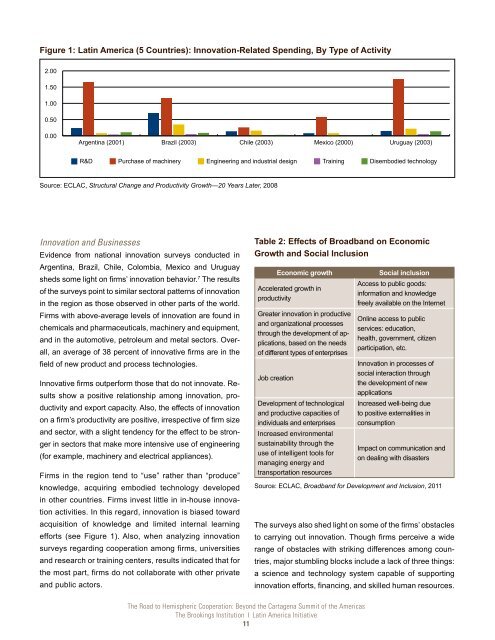The Road to Hemispheric Cooperation: Beyond the Cartagena
The Road to Hemispheric Cooperation: Beyond the Cartagena
The Road to Hemispheric Cooperation: Beyond the Cartagena
You also want an ePaper? Increase the reach of your titles
YUMPU automatically turns print PDFs into web optimized ePapers that Google loves.
Figure 1: Latin America (5 Countries): Innovation-Related Spending, By Type of Activity<br />
2.00<br />
1.50<br />
1.00<br />
0.50<br />
0.00<br />
Argentina (2001)<br />
Innovation and Businesses<br />
Brazil (2003)<br />
Evidence from national innovation surveys conducted in<br />
Argentina, Brazil, Chile, Colombia, Mexico and Uruguay<br />
sheds some light on firms’ innovation behavior. 7 <strong>The</strong> results<br />
of <strong>the</strong> surveys point <strong>to</strong> similar sec<strong>to</strong>ral patterns of innovation<br />
in <strong>the</strong> region as those observed in o<strong>the</strong>r parts of <strong>the</strong> world.<br />
Firms with above-average levels of innovation are found in<br />
chemicals and pharmaceuticals, machinery and equipment,<br />
and in <strong>the</strong> au<strong>to</strong>motive, petroleum and metal sec<strong>to</strong>rs. Overall,<br />
an average of 38 percent of innovative firms are in <strong>the</strong><br />
field of new product and process technologies.<br />
Innovative firms outperform those that do not innovate. Results<br />
show a positive relationship among innovation, productivity<br />
and export capacity. Also, <strong>the</strong> effects of innovation<br />
on a firm’s productivity are positive, irrespective of firm size<br />
and sec<strong>to</strong>r, with a slight tendency for <strong>the</strong> effect <strong>to</strong> be stronger<br />
in sec<strong>to</strong>rs that make more intensive use of engineering<br />
(for example, machinery and electrical appliances).<br />
Firms in <strong>the</strong> region tend <strong>to</strong> “use” ra<strong>the</strong>r than “produce”<br />
knowledge, acquiring embodied technology developed<br />
in o<strong>the</strong>r countries. Firms invest little in in-house innovation<br />
activities. In this regard, innovation is biased <strong>to</strong>ward<br />
acquisition of knowledge and limited internal learning<br />
efforts (see Figure 1). Also, when analyzing innovation<br />
surveys regarding cooperation among firms, universities<br />
and research or training centers, results indicated that for<br />
<strong>the</strong> most part, firms do not collaborate with o<strong>the</strong>r private<br />
and public ac<strong>to</strong>rs.<br />
Chile (2003)<br />
Mexico (2000)<br />
<strong>The</strong> <strong>Road</strong> <strong>to</strong> <strong>Hemispheric</strong> <strong>Cooperation</strong>: <strong>Beyond</strong> <strong>the</strong> <strong>Cartagena</strong> Summit of <strong>the</strong> Americas<br />
<strong>The</strong> Brookings Institution ❘ Latin America Initiative<br />
11<br />
Uruguay (2003)<br />
R&D Purchase of machinery Engineering and industrial design Training Disembodied technology<br />
Source: ECLAC, Structural Change and Productivity Growth—20 Years Later, 2008<br />
Table 2: Effects of Broadband on Economic<br />
Growth and Social Inclusion<br />
Economic growth Social inclusion<br />
Accelerated growth in<br />
productivity<br />
Greater innovation in productive<br />
and organizational processes<br />
through <strong>the</strong> development of applications,<br />
based on <strong>the</strong> needs<br />
of different types of enterprises<br />
Job creation<br />
Development of technological<br />
and productive capacities of<br />
individuals and enterprises<br />
Increased environmental<br />
sustainability through <strong>the</strong><br />
use of intelligent <strong>to</strong>ols for<br />
managing energy and<br />
transportation resources<br />
Access <strong>to</strong> public goods:<br />
information and knowledge<br />
freely available on <strong>the</strong> Internet<br />
Online access <strong>to</strong> public<br />
services: education,<br />
health, government, citizen<br />
participation, etc.<br />
Innovation in processes of<br />
social interaction through<br />
<strong>the</strong> development of new<br />
applications<br />
Increased well-being due<br />
<strong>to</strong> positive externalities in<br />
consumption<br />
Impact on communication and<br />
on dealing with disasters<br />
Source: ECLAC, Broadband for Development and Inclusion, 2011<br />
<strong>The</strong> surveys also shed light on some of <strong>the</strong> firms’ obstacles<br />
<strong>to</strong> carrying out innovation. Though firms perceive a wide<br />
range of obstacles with striking differences among countries,<br />
major stumbling blocks include a lack of three things:<br />
a science and technology system capable of supporting<br />
innovation efforts, financing, and skilled human resources.








